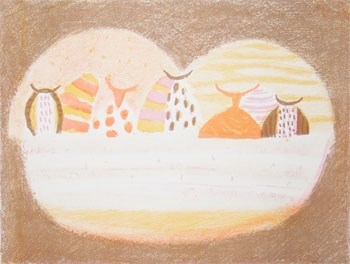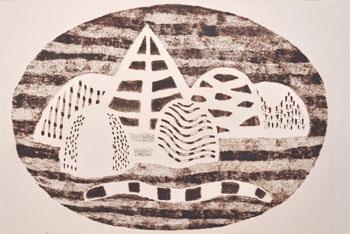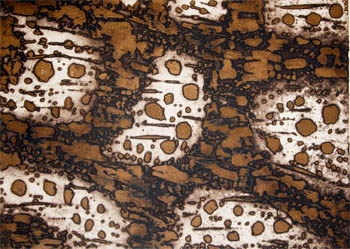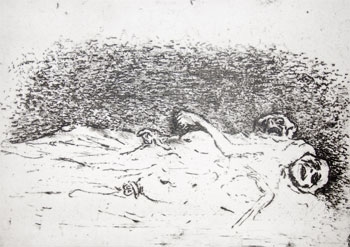Slovene painters 1: Zoran Music Multi-cache
icabrian: Muzej je do nadaljnjega zaprt / Museum closed until further notice
Slovene painters 1: Zoran Music
-
Difficulty:
-

-
Terrain:
-

Size:  (regular)
(regular)
Please note Use of geocaching.com services is subject to the terms and conditions
in our disclaimer.
Slovenski slikarji #1: Zoran Mušič - obiščite Goriška Brda in muzej v gradu Dobrovo
Slovene painters #1: Zoran Mušič - visit Goriška Brda and museum in Dobrovo castle
 Zoran Mušic (glej Wikipedijo za izčrpnejši življenjepis) je bil slikarski mojster sodobne Evrope in edini slikar slovenskega rodu, ki se mu je v 20. stoletju uspelo prebiti v elitne kulturne kroge v Italiji in Franciji. Rojen je bil 12. februarja 1909 v Bukovici pri Gorici, kjer sta bila njegova starša učitelja. Po razpadu Avstro-Ogrske monarhije je bila družina večkrat razseljena in izgnana, dokler se ni leta 1920 ustalila na Štajerskem, kjer je Zoran nadaljeval šolanje na realki v Mariboru. Leta 1929 se je vpisal na Akademijo likovne umetnosti v Zagrebu, kjer je diplomiral leta 1934. Naslednje leto je študijsko obiskal Španijo, dela Goye in El Greca v madridskem Pradu ter daljša slikarska potovanja v Dalmacijo v letih 1934-40 so pomembno vplivala na ves njegov nadaljnji razvoj. Po letu 1940 je živel v Ljubljani, leta 1943 pa je prišel v Benetke, kjer se je povezal s slikarskim krogom Filippa de Pisisa in doživel precejšen uspeh z razstavama v Benetkah in Trstu. Jeseni 1944 je bil aretiran in odpeljan v koncentracijsko taborišče Dachau, kjer je, zlasti po osvoboditvi taborišča med čakanjem na vrnitev v domovino, nastala zbirka risb o nacističnih grozodejstvih, ki jih je na platnu znova povzel v 70. letih v znamenitem ciklusu Nismo poslednji. Iz taborišča se je vrnil v Ljubljano, od koder je zaradi groženj takratne oblasti poleti 1945 odšel v Gorico in nato v Benetke (v Slovenijo se ni več vrnil do leta 1956). Leta 1949 se je poročil s slikarko Ido Cadorin. Nagrada Premio Parigi, ki jo je prejel leta 1952 v Cortini d'Ampezzo na natečaju Italijanskega kulturnega centra v Parizu, mu je odprla vrata v Pariz, kjer si je uredil atelje in ustvarjal pod okriljem takrat ene najpomembnejših pariških galerij Galerie de France. Vse svoje zrelo obdobje je preživel med Benetkami in Parizom, kjer je vseskozi razstavljal. Leta 1995 so mu v pariški Veliki palači (Grand Palais) pripravili veliko retrospektivno razstavo (kot do takrat edinemu še živečemu slikarju, ki je bil deležen te časti), ki sta jo skupaj odprla njegov osebni prijatelj francoski predsednik François Mitterrand in slovenski predsednik Milan Kučan. Umrl je 25. maja 2005 na svojem domu v Benetkah.
Zoran Mušic (glej Wikipedijo za izčrpnejši življenjepis) je bil slikarski mojster sodobne Evrope in edini slikar slovenskega rodu, ki se mu je v 20. stoletju uspelo prebiti v elitne kulturne kroge v Italiji in Franciji. Rojen je bil 12. februarja 1909 v Bukovici pri Gorici, kjer sta bila njegova starša učitelja. Po razpadu Avstro-Ogrske monarhije je bila družina večkrat razseljena in izgnana, dokler se ni leta 1920 ustalila na Štajerskem, kjer je Zoran nadaljeval šolanje na realki v Mariboru. Leta 1929 se je vpisal na Akademijo likovne umetnosti v Zagrebu, kjer je diplomiral leta 1934. Naslednje leto je študijsko obiskal Španijo, dela Goye in El Greca v madridskem Pradu ter daljša slikarska potovanja v Dalmacijo v letih 1934-40 so pomembno vplivala na ves njegov nadaljnji razvoj. Po letu 1940 je živel v Ljubljani, leta 1943 pa je prišel v Benetke, kjer se je povezal s slikarskim krogom Filippa de Pisisa in doživel precejšen uspeh z razstavama v Benetkah in Trstu. Jeseni 1944 je bil aretiran in odpeljan v koncentracijsko taborišče Dachau, kjer je, zlasti po osvoboditvi taborišča med čakanjem na vrnitev v domovino, nastala zbirka risb o nacističnih grozodejstvih, ki jih je na platnu znova povzel v 70. letih v znamenitem ciklusu Nismo poslednji. Iz taborišča se je vrnil v Ljubljano, od koder je zaradi groženj takratne oblasti poleti 1945 odšel v Gorico in nato v Benetke (v Slovenijo se ni več vrnil do leta 1956). Leta 1949 se je poročil s slikarko Ido Cadorin. Nagrada Premio Parigi, ki jo je prejel leta 1952 v Cortini d'Ampezzo na natečaju Italijanskega kulturnega centra v Parizu, mu je odprla vrata v Pariz, kjer si je uredil atelje in ustvarjal pod okriljem takrat ene najpomembnejših pariških galerij Galerie de France. Vse svoje zrelo obdobje je preživel med Benetkami in Parizom, kjer je vseskozi razstavljal. Leta 1995 so mu v pariški Veliki palači (Grand Palais) pripravili veliko retrospektivno razstavo (kot do takrat edinemu še živečemu slikarju, ki je bil deležen te časti), ki sta jo skupaj odprla njegov osebni prijatelj francoski predsednik François Mitterrand in slovenski predsednik Milan Kučan. Umrl je 25. maja 2005 na svojem domu v Benetkah.
Zoran Mušič (see Wikipedia and especially French Wikipedia for detailed biography) was one of the masters of painting of modern Europe and the only painter of Slovene origin in 20th Century that established himself in the elite cultural circles in Italy and France. He was born on February 12, 1909 in Bukovica near Gorica, where both his parents were teachers. After the breakup of Austro-Hungarian monarchy his family was displaced and exiled several times before settling in 1920 in Štajerska region, where Zoran attended high school in Maribor. In 1929 he was accepted to the Academy of Fine Arts in Zagreb, where he graduated in 1934. He travelled to Spain in 1935, paintings of Goya and El Greco from Prado museum in Madrid, along with his frequent painting travels to Dalmatia in 1934-40, remained permanent influence in his artistic development. From 1940-1943 he lived in Ljubljana and then moved to Venice, where he linked with Filippo de Pisis and his circle and held two successful exhibitions in Venice and Trieste. In the autumn of 1944 he was arrested and deported to Nazi concentration camp in Dachau, where he, mostly while waiting for transfer back to homeland after liberation of the camp, made sketches and drawings of Nazi deeds of horror. These experiences were brought to light again in 1970's in the famous cycle We are not the last. He briefly returned to Ljubljana, but was forced to leave under the threat of the authorities in summer 1945 to Gorica and then to Venice (not to return to Slovenia until 1956). In 1949 he married a painter Ida Cadorin. In 1952 he won the prize Premio Parigi in a contest, organised in Cortina d'Ampezzo by Italian cultural centre in Paris, that opened him the way to Paris, where he established an atelier and worked with support of influential Galerie de France. His mature artistic period was spent between Venice and Paris, where he regularly exhibited in most important galleries. In 1995, a major retrospective exhibition of his work was organised in Grand Palais in Paris (up to that time the only living artist that was honoured with an exhibition in this prestigious venue) that was opened by his personal friend French president François Mitterrand and Slovene president Milan Kučan. Zoran Mušič died at his home in Venice on May 25, 2005.
Grafična zbirka v gradu Dobrovo, edina stalna zbirka Mušičevih del, je bila odprta leta 1991 v tedaj prenovljenem gradu. V zbirki je zajetih 134 grafičnih listov, ki jih je slikar podaril novogoriški občini konec 80. in v začetku 90. let prejšnjega stoletja. Objavljene koordinate vas pripeljejo pred grad Dobrovo, v katerem je Galerija Zorana Mušiča. Za izračun končnih koordinat, pa ne samo zato, si natančno oglejte razstavljene grafike v 5 sobah in glavni dvorani. Naloge ni mogoče rešiti drugače kot z obiskom galerije v Dobrovem. Galerija je odprta od 8h do 16h (torek-petek) oziroma od 13h do 17h (sobota, nedelja, prazniki) in zaprta ob ponedeljkih. Vstopnina za ogled celega gradu je simbolična (2 EUR odrasli, za otroke brezplačno). Dan lahko porabite še za katero od pešpoti po Brdih ali za vzpon na Korado (kjer je tudi zaklad GC26777).
The collection in Dobrovo castle, the only permanent exhibition of Mušič's works, was opened in 1991 in then renovated castle. It was founded by donation of 134 graphic prints by the artist to Nova Gorica at the end of 1980's and beginning of 1990's. Published coordinates will bring you in front of Dobrovo castle that hosts the gallery (Galerija Zorana Mušiča). To calculate final coordinates, but also to enjoy masterpieces of modern art, examine closely the prints in 5 rooms and main hall. The task can only be completed by a visit to the gallery in Dobrovo castle. Gallery opening times are 8-16h (Tuesday-Friday) and 13-17h (Saturday, Sunday, public holidays), closed on Monday. Entrance fee for visit of the whole castle is symbolic (adults 2 EUR, children free). You can spend the rest of the day on one of many hiking trails in Brda or by hiking to the summit of Korada (and collect the cache GC26777).
1. Dalmatinska pokrajina je bila za Mušiča vseskozi pomemben navdih. Z motivi konjičkov, žensk, ki natovarjajo osličke (kasneje močno reduciranimi v samosvoj likovni jezik), in brodnikov, ki prevažajo živino čez reko, je prvič pritegnil mednarodno pozornost, slike in grafike konjičkov pa so ostale do danes njegova najbolj iskana dela. Oglejte si grafiko Konjički iz leta 1949 (na sliki spodaj): litografija, ki je bila natisnjena v 200 izvodih, je levo spodaj oštevilčena »pp/200«.
Features of Dalmatian landscape were a permanent influence in Mušič's work. Paintings of horses, women loading donkeys and livestock trasported on a ferry first drew international attention to Mušič and remained one of his most wanted works until today. Examine the print Horses (Cavallini) from 1949 depicted below: lithograph, that was printed in an edition of 200, is numerated lower left as »pp/200«.
A=pp

2. Poiščite litografijo iz leta 1955 s fotografije spodaj.
Find the lithograph from 1955 depicted below.
B = število črk v francoskem naslovu (druga vrstica na kovinski ploščici, dve besedi)
B = number of letters in the french title of the lithograph (second line on a brass plate, two words)

3. Po letu 1950 se pričnejo v Mušičevem slikarstvu poleg dalmatinskih pogosteje pojavljati motivi sienske pokrajine, ki je slikarja spominjala na domača Brda, kasneje pa tudi motivi ribiških mrež in bark iz Chioggie in Pellestrine. Poiščite grafiko Sienska pokrajina s slike spodaj, ki je desno spodaj podpisana z »Music qq«.
After 1950, paintings of Sienese landscapes become more frequent in Mušič's work (the countryside of Tuscany around Siena reminded the artist strongly on Brda), and later also paintings of fishing nets and boats at Chioggia and Pellestrina. Find the print Paysage siennois depicted below, that bears a signature »Music qq« in lower right corner.
C = qq

4. Poiščite grafiko Ribiške mreže v Chioggii (na sliki spodaj), ki je levo spodaj oštevilčena »19/rr«.
Find the print Fishing nets in Chioggia (Fischkörbe in Chioggia) depicted below, that is numerated »19/rr« in lower left corner.
D=rr.

5. Druga polovica 60. let je prinesla več uspešnih literarno-likovnih projektov s francoskima pesnikoma in pisateljema Jeanom Lescurom in Alainom Bosquetom, za katere je Mušič prispeval grafike ali risbe. Poiščite grafike, ki so izšle leta 1965 v mapi La terre écrit la terre (Zemlja piše zemljo).
In the second part of 1960's Mušič succesfully collaborated with French writers and poets Jean Lescure and Alain Bosquet on projects, for which he contributed prints or drawings. Find the prints that were published in the portfolio La terre écrit la terre in 1965.
E = Število razstavljenih grafik iz te mape (vse visijo na isti steni)
E = Numer of exhibited prints from this portfolio (all are hanging on the same wall).
6. Za Mušičevo ustvarjanje v drugi polovici 70. let so značilne skoraj ezoterične krajine Dolomitov, ki kasneje preidejo v podobe pustih skalnatih pokrajin. Poiščite grafiko z naslovom Kamnita pokrajina / Paysage Rocheux C, oštevilčeno 1/30, ki je bila natisnjena leta »19ss«.
Typical for Mušič's painting in the second half of 1970's are almost esoteric Dolomites landscapes that later transform into deserted rocky landscapes. Find the print titled Paysage Rocheux C, numerated 1/30, that was printed in the year »19ss«.
F = ss.
7. Mušičevo ustvarjanje v grafiki se zakljuci v 80. letih, čeprav je tudi kasneje, do nekaj let pred smrtjo, še odtisnil nekaj jedkanic in litografij. Zadnja grafična dela, ki so izšla v večji nakladi, so v galeriji zbrana v sobi 5. Poleg kamnitih pokrajin so v tej sobi tudi krajine iz leta 1981, ki prikazujejo pogled na pristanišče nekega v slikarjevem življenju zelo pomembnega mesta.
Mušič's graphic opus ended in 1980's even though he later, up to few years before death, produced several etchings and lithographs in very small editions. His last graphic works that were printed in larger editions are displayed in room 5. In this room, along with rocky landscapes, you will find atmospheric views of a port in a city, very important for artist's life, printed in 1981.
G = število črk v imenu tega mesta.
G = Number of letter in the name of the city
8. Najmlajše Mušičeve grafike v zbirki v Dobrovem nosijo letnico »19tt«.
Most recent prints in Dobrovo collection are from the year »19tt«.
H = tt.
9. Grafike, ki so razstavljene v glavni dvorani, si oglejte zadnje. Na steni nasproti vhoda so razstavljene grafike iz ciklusa Dalmatinska in Istrska zemlja, ki so nastale konec 50. in v začetku 60. let kot slikarjev poskus, da bi se približal abstraktnemu slikarstvu (čeprav je Mušič sam večkrat zanikal, da gre za abstraktna dela). Poiščite grafiko s spodnje slike, ki je desno spodaj podpisana z »Music uu«.
Prints that are on display in the main hall should be viewed last. On the wall opposite to the entrance you will find prints from the cycle Terres Dalmates and Terres d'Istrie from late 1950's and early 1960's. This cycle is generally accepted as artist's attempt to approach abstract painting, although Mušič himself maintained that these subjects are not abstract. Find the print depicted below that is signed »Music uu« in lower right corner.
I = uu.

10. Na steni poleg vhoda v glavno dvorano so razstavljene grafike iz ciklusa Nismo poslednji (Nous ne sommes pas les derniers). Mušič je v zacetku 70. let v slikah in grafikah ponovno podoživel izkušnje iz nacističnega koncentracijskega taborišča Dachau, naslov ciklusa pa odraža varljivost upanja nekdanjih taboriščnikov ob tedanjih dogodkih v svetu, da je bil Dachau poslednja postaja v zgodovini človeške norosti, groze in nasilja. Nastala so pretresljiva dela, ki so mu prinesla svetovno slavo in priznanje in jih mnogi štejejo za vrhunec njegovega ustvarjanja. Najdi grafiko s spodnje slike, ki je levo spodaj oštevilčena z »ww/60«.
Wall next to the entrance to the gallery displays prints from the famous cycle We are not the last (Nous ne sommes pas les derniers). Starting in 1970 Mušič brought again to light his experiences from Nazi concentration camp Dachau in paintings and prints, with the title of the cycle reflecting false hope of former concentration camp inmates that Dachau was the last station in the history of human madness, terror and violence. Almost schocking works brought him world fame and wide critical acclaim and are regarded by many as his highest artistic achievement. Find the print depicted below that is numerated »ww/60« in lower left corner.
J=ww.

11. Najdi grafiko s spodnje slike, ki je levo spodaj oštevilčena z »xx/yy« in desno spodaj podpisana »Music zz«.
Find the print depicted below that is numerated »xx/yy« in lower left corner and signed »Music zz« in lower right corner.
K = xx+yy-zz

Zaklad je skrit na koordinatah
Cache is hidden on coordinates:
N 45 LM.NOP
E 013 QR.STU
Kjer je
where
LM = I
NOP = (A x B) + (C x E) - D x (A - F) - (E + D - I)
QR = K - G
STU = H + I + J + K - (B x G) + G
Kontrolni seštevek, s katerim lahko že v galeriji preverite pravilnost rešitve:
Checksum to check the correct solution:
A + B + C + D + E + F + G + H + I + J + K = 529
Začetna vsebina: beležka, svinčnik in šilček (prosim ne odnesi), neaktiviran travelbug za prvega najditelja, magnetki (izdelani posebej za ta zaklad, brez menjave prosim vzemite le enega na skupino) in nekaj drugih malenkosti za menjavo.
Initial content: logbook, pencil and pencil sharpener (please do not remove), unactivated travelbug for the First to find, fridge magnets (custom made for this cache, please do not take more than one per group without trade), some small exchange items.
Glej tudi / See also:
- Starodavni zapis / Ancient inscription
- Slovene painters 2: Stane Kregar
- Slovene painters 3: Luigi Kasimir
- Zakladi Narodne galerije / National Gallery
- Zakladi Moderne galerije / Museum of Modern Art
Additional Hints
(Decrypt)
Cybfpngv xnzav bo qerirfh / Syng fgbarf ng gur sbbg bs n gerr